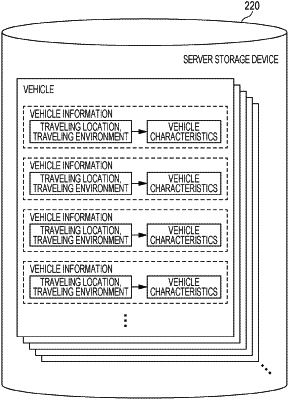| CPC G08G 1/017 (2013.01) [B60W 40/09 (2013.01); G06N 20/00 (2019.01); H04W 4/44 (2018.02); B60W 50/10 (2013.01)] | 4 Claims |

|
1. A vehicle system comprising:
an information storage configured to store vehicle information of a plurality of sample vehicles in association with the plurality of sample vehicles, the vehicle information being obtained by combining either or both of a traveling location and a traveling environment with adjustable vehicle characteristics corresponding to either or both of the traveling location and the traveling environment of the plurality of sample vehicles;
a communication device configured to communicate with a first vehicle; and
at least one processor configured to:
receive a first information from the first vehicle via the communication device, the first information is obtained by combining either or both of a first traveling location of the first vehicle and a first traveling environment of the first vehicle with adjustable vehicle characteristics of the first vehicle corresponding to either or both of the first traveling location and the first traveling environment of the first vehicle;
receive a second information from the first vehicle via the communication device, the second information includes either or both of a second traveling location and a second traveling environment in which the first vehicle has never traveled, the second information lacking adjustable vehicle characteristics of the first vehicle corresponding to either or both of the second traveling location and the second traveling environment in which the first vehicle has never traveled;
in response to receiving the first and second information, select a second vehicle from among the plurality of sample vehicles by:
determining a first sample vehicle that has the highest matching degree of the vehicle information between the first information among the plurality of sample vehicles, the highest matching degree corresponding to either or both of the first traveling location and the first traveling environment acquired from the second vehicle,
determining whether the vehicle information of the first sample vehicle includes adjustable vehicle characteristics corresponding to the second information received from the first vehicle, the adjustable vehicle characteristics being one or more of prioritized acceleration, prioritized fuel economy, brake strength, suspension strength, power-steering strength, transmission mode, and air-conditioning strength,
in a case where the first sample vehicle includes the adjustable vehicle characteristics corresponding to the second information received from the first vehicle, selecting the first sample vehicle as the second vehicle,
in a case where the first sample vehicle does not include the adjustable vehicle characteristics corresponding to the second information received from the first vehicle, (i) determining another sample vehicle with a next highest matching degree of the vehicle information, (ii) determining whether the vehicle information of the another sample vehicle includes the adjustable vehicle characteristics corresponding to the second information received from the vehicle, (iii) in a case where the another sample vehicle does not include the adjustable vehicle characteristics corresponding to the second information received from the first vehicle, repeating (i) and (ii) until a second sample vehicle is determined that includes adjustable vehicle characteristics corresponding to the second information received from the vehicle, and (iv) selecting the another sample vehicle or the second sample vehicle that includes the adjustable vehicle characteristics corresponding to the second information received from the first vehicle as the second vehicle; and
transmit the adjustable vehicle characteristics of the second vehicle corresponding to the second information to the first vehicle via the communication device.
|